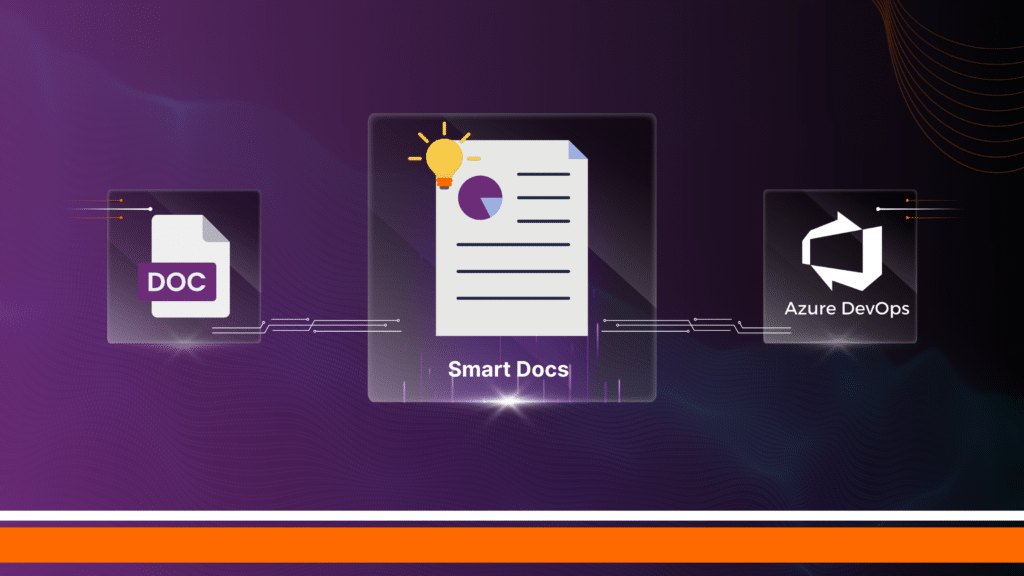
Smart Docs: Your One-Stop Tool for Azure DevOps Documentation
- Modern Requirements
- February 25, 2025
- 9 minutes
Are you a professional who uses Azure DevOps to manage project requirements? If yes, you might be one of those persons who are facing issues in creating and maintaining requirement documentation, as Azure DevOps has limited features for the same. This is where Smart Docs fills the gap.
A recent survey shows that knowledge workers spend 50% of their time keeping documents clear and updated. Without reliable document systems, 25% of documents are lost.
What if you could simplify creating structured and living requirements documents in Azure DevOps with a single tool?
Yes, you heard it right!
Smart Docs is a module within Modern Requirements4DevOps, a tool offered by Modern Requirements (a natively built-in solution for requirements management in Azure DevOps), which makes building and updating requirement documents easier within Azure DevOps.
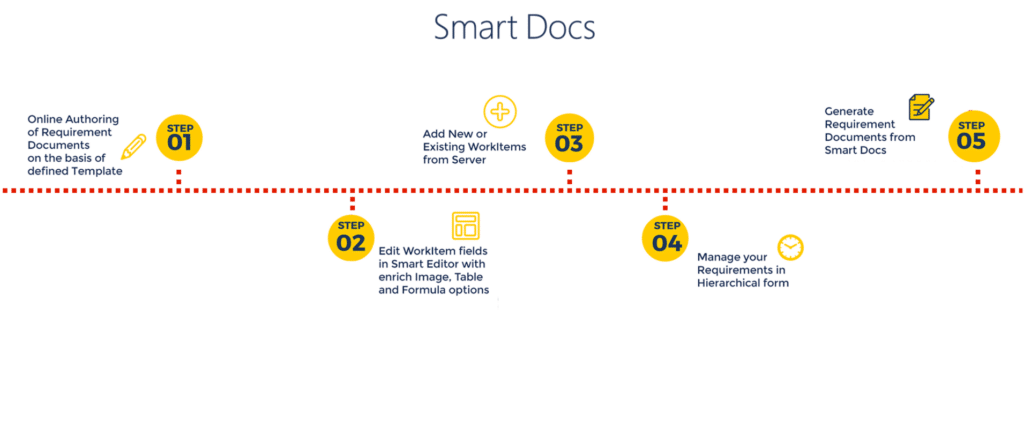
This content module guides you on how to create enriched documents within Azure DevOps using Smart Docs.
Table of Contents
What is Smart Docs?
Smart Docs is an online document authoring and processing system that is built directly into Azure DevOps. As part of the Modern Requirements4DevOps Enterprise Edition, this module offers an editor similar to Microsoft Word to create structured documents and edit them.
Smart Docs allows teams to create a Smart Doc, a living requirements document. It is designed to integrate your project requirements with live data from your backlog into the documents. It always ensures that updates in requirements are automatically reflected in the document.
Furthermore, it simplifies the document creation process by offering reusable meta templates, document template
s, familiar text formatting options, and other editing options without leaving the Azure DevOps environment.
No matter what kind of requirements documentation you need to manage with Smart Docs, it caters to all, such as:
- Business Requirements Documents
- System Requirements Documents
- Functional/Non-functional Requirements Documents
- Product Requirements Documents
Using Smart Docs directly in your Azure DevOps workspace ensures that all information stays consistent and accessible across your team.
Key Features That Make Smart Docs Stand Out
Smart Docs comes with lots of features that make documentation easier and more efficient within Azure DevOps. These features enable your team to create, update, and maintain project documents effortlessly.
Let’s explore some of the standout features below.
Rich Formatting Tools: Enhance Your Content
Smart Docs offers a robust set of formatting tools similar to Microsoft Word that help you build professional documents within Azure DevOps. Its user-friendly interface allows easy text and content formatting without the need to switch applications.
Formatting options include:
- Bold, italics, and underline
- Bulleted and numbered lists
- Headings
- Tables
These tools ensure the highest standards by keeping your documentation clear, engaging, and easy to navigate.
Instant Document Sync: Keep It Always Up-to-Date
Instant document sync updates the Smart Doc as soon as any editing is done to it. Hence, all team members view real-time changes and the latest version of the Smart Docs without any delay.
It also helps avoid unnecessary manual refreshes and reduces the chances of error caused by referring to outdated information.
Smart Version Control: Track Every Change
With Smart Version Control, every edit is recorded so that you will have no trouble tracking a change. You can compare versions and restore previous drafts with just a few clicks.
This feature provides a clear audit trail so that nothing can be lost. It increases accountability and helps teams locate errors and rectify them in no time. With version control in place, your documentation remains reliable and secure.
Reusable Templates: Create Consistency Fast
Reusable templates let you save your favorite document structures for future projects, ensuring every Smart Doc follows a consistent style and layout.
Smart Docs offers 2 types of templates:
- Meta Templates: Meta templates define comprehensive document structures that organize sections, headers, and document types consistently. They serve as blueprints for creating standardized documentation sets.
- Document Templates: Document templates offer pre-built content layouts for individual documents, ensuring consistent formatting and style for every Smart Doc produced in your project.
Import Word Documents: Migrate Your Legacy Files Seamlessly
Smart Docs lets you easily import existing Word documents directly into your Azure DevOps project. This feature converts your legacy files into an editable format, preserving your original formatting and structure so you don’t have to start from scratch.
By migrating your existing documentation, you save time and reduce errors associated with manual re-entry or copy/paste. This seamless integration enables your team to continue working on familiar content while enjoying the benefits of centralized, real-time updates and collaboration within Smart Docs.
Direct Requirements Linking to Project Documents
Direct Requirements Linking ties your Smart Doc directly to project requirements. When a requirement changes, Smart Doc updates automatically, ensuring accuracy across the project.
This seamless integration minimizes manual updates and keeps everyone aligned with the latest information. It is especially beneficial for teams that need to maintain strict traceability and compliance, reducing administrative overhead and improving collaboration.
Real-Life Use Cases of Smart Docs
Smart Docs is transforming the way teams handle project documentation in Azure DevOps. Here are three real-world examples that show its impact:
Use Case 1: Eliminating Manual Copy-Pasting
For teams that spend precious time copying requirements from Azure DevOps into Microsoft Word, the process is not only slow but also prone to mistakes. Smart Docs lets you create and maintain your documentation directly within your project. This integrated method ensures that every change in the backlog is immediately reflected in your documents, keeping them accurate and ready for export.
Use Case 2: Avoiding Duplicate Efforts
Some teams stop updating documentation because they must maintain two separate records, one for requirements and another for documents. Smart Docs resolves this by letting you either drag existing requirements into your Smart Doc or type new ones directly into the editor. As a result, every requirement is automatically added to the project’s backlog, creating a single, unified source of truth that saves time and prevents redundant work.
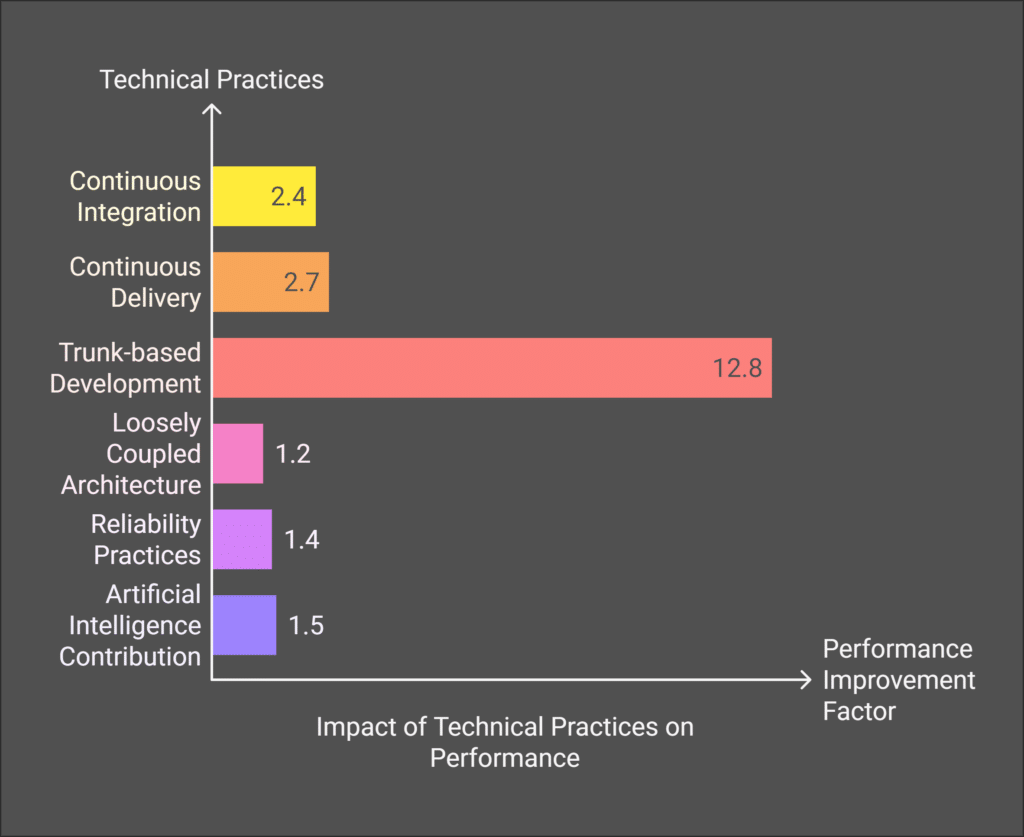
How to Use Smart Docs in Azure DevOps?
First, ensure that your Azure DevOps project is subscribed to Modern Requirements4DevOps. Once this subscription is in place, navigate to your project board and click on the Smart Docs section to begin setting up your documentation workflow.
Step 1: Create a Meta Template
Start by designing a meta template that sets the framework for your Smart Doc. This template determines where different content types, like context sections and requirement placeholders, will go.
- Example: If your team routinely produces Business Requirements Documents, set up a meta template with sections for the Introduction, Scope, and Requirements. This single setup can be reused across multiple projects.
Step 2: Create a New Smart Doc
Using the meta template, generate a new Smart Doc. The Smart Doc will automatically adopt the structure you defined, ensuring consistency and saving time on formatting.
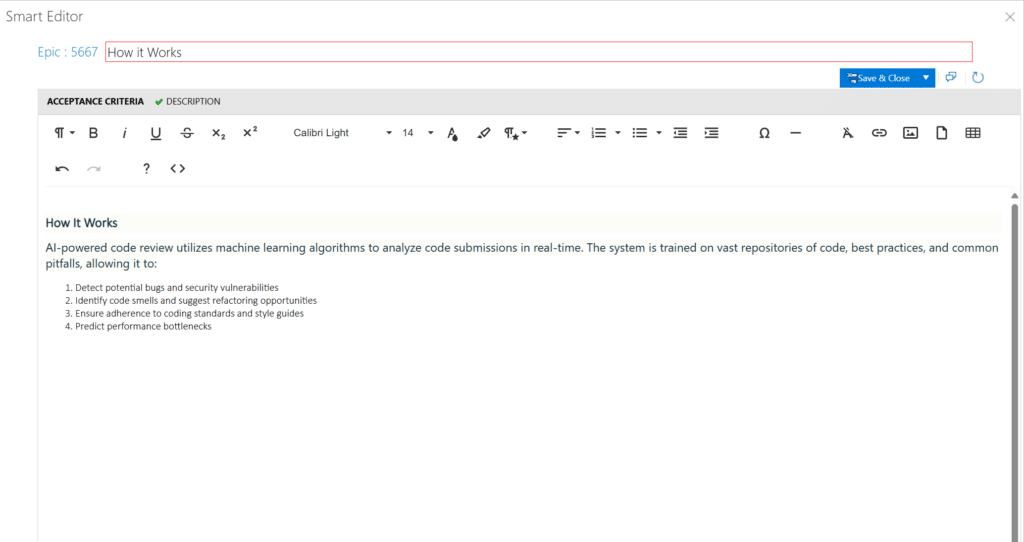
Step 3: Add or Import Requirements
Populate your Smart Doc by adding requirements in one of two ways:
- Drag-and-Drop: Import existing requirements from your Azure DevOps backlog directly into your Smart Doc.
- Create New: Type new requirements directly in the Smart Doc, and they will automatically be added to your project’s backlog. This unified approach minimizes redundant work.
Step 4: Utilize Reusable Document Templates
If your team has standard content that you use repeatedly, create a document template. This helps you quickly generate new Smart Docs with a pre-defined layout and style, reducing setup time and ensuring uniformity.
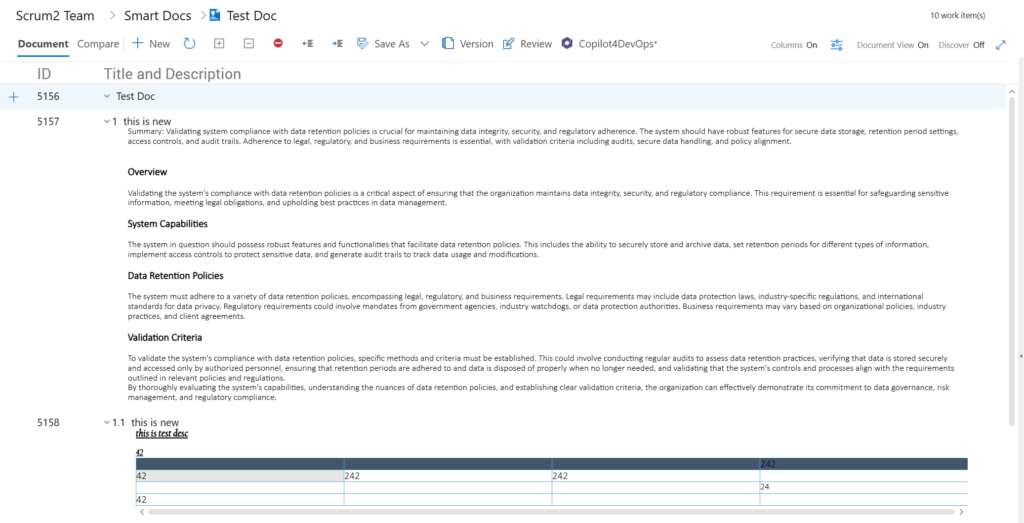
Step 5: Manage Versions and Send for Review
After editing your Smart Doc, create a new version to track changes over time. This version management allows you to compare iterations and maintain a history of updates.
Finally, use the built-in review module in Modern Requirements4DevOps to send the Smart Doc for stakeholder feedback. This collaborative review process helps finalize the document in one efficient cycle, keeping everything accurate and up-to-date.

Copilot4DevOps: Your AI Assistant for Creating Documents Using Smart Docs
When you subscribe to Modern Requirements4DevOps, you also receive the free version of Copilot4DevOps Lite. This smart AI tool helps your team gather new requirements with minimal manual effort and ensures your documentation stays current
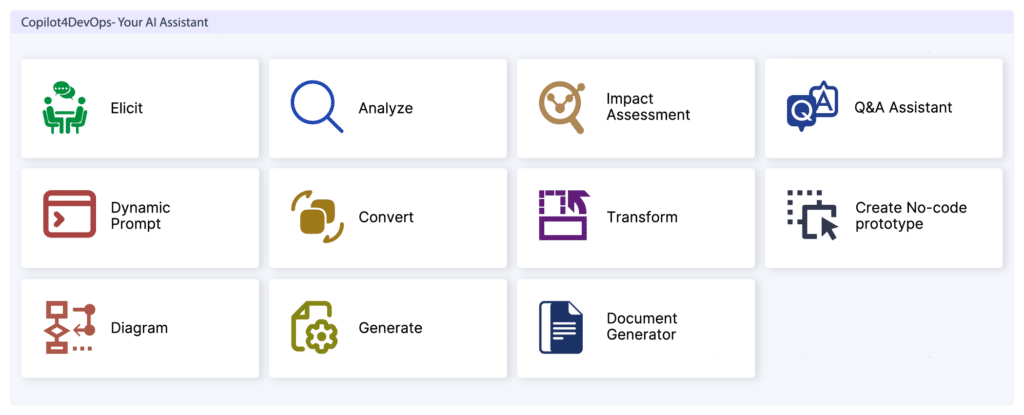
You can invoke Copilot4DevOps from the backlog or from Smart Docs to use AI to generate or add to documents in various ways:
- Elicitation of New Requirements: Copilot4DevOps can process inputs and generate fresh requirements, which are instantly added to your Smart Doc. Here’s how it works:
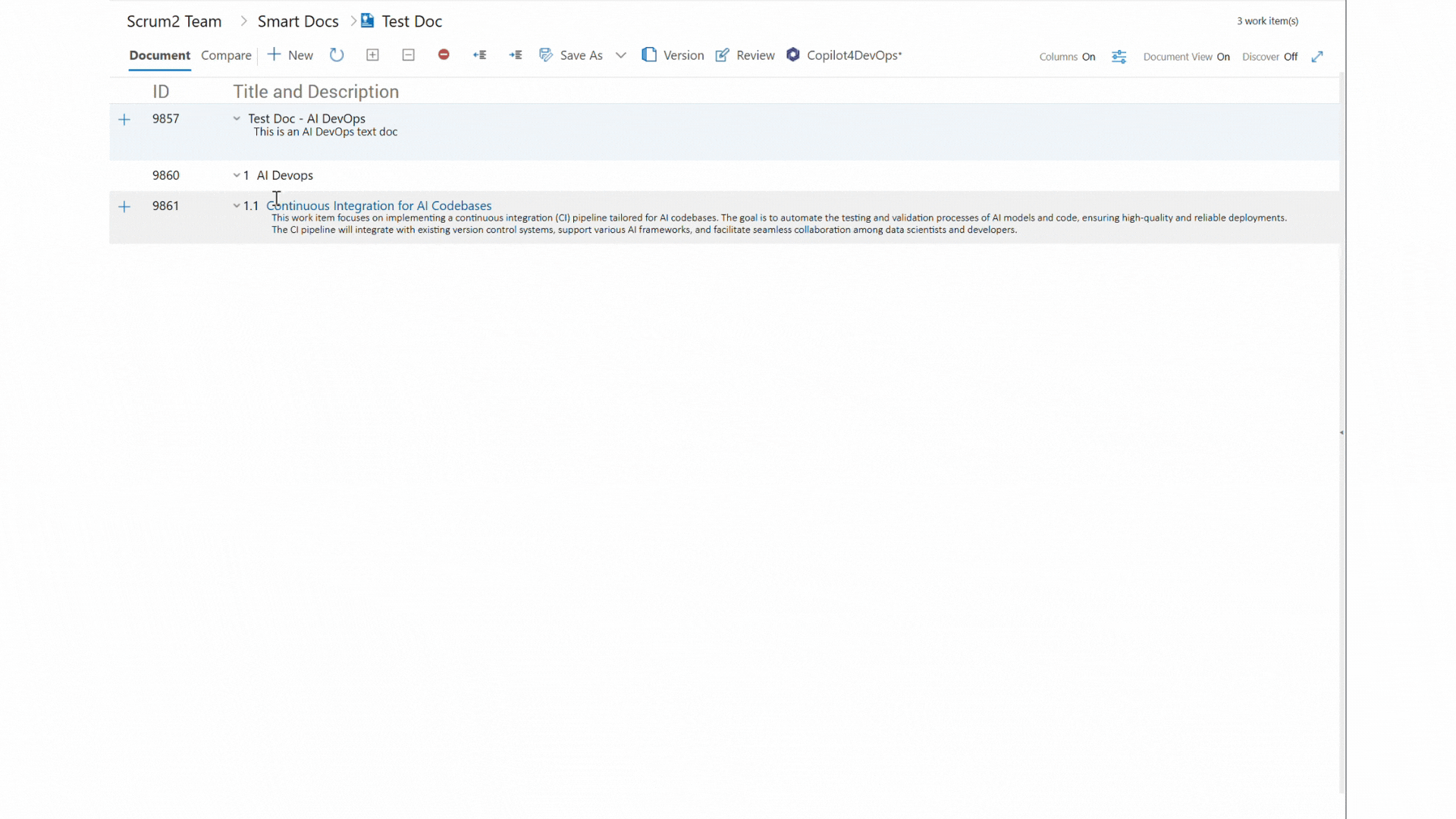
- Generate high-quality requirements, features, bugs, test cases, and more.
- Analyze document quality using various writing and prioritization methods (6C, MoSCoW, INVEST, etc.)
- Convert requirements to different formats like user stories, use cases, and Gherkin.
- Create custom prompts for specific document sections or boilerplate text blocks to speed up work item generation.
- Summarize, paraphrase, or elaborate documents.
By automating these tasks, Copilot4DevOps saves time and minimizes errors, keeping your documentation reliable and up to date.
You can use Copilot4DevOps for free to boost your team’s productivity with AI-driven requirements management. You can also upgrade to Copilot4DevOps Plus or Ultimate to get even more intuitive features.
Azure DevOps and Modern Requirements4DevOps
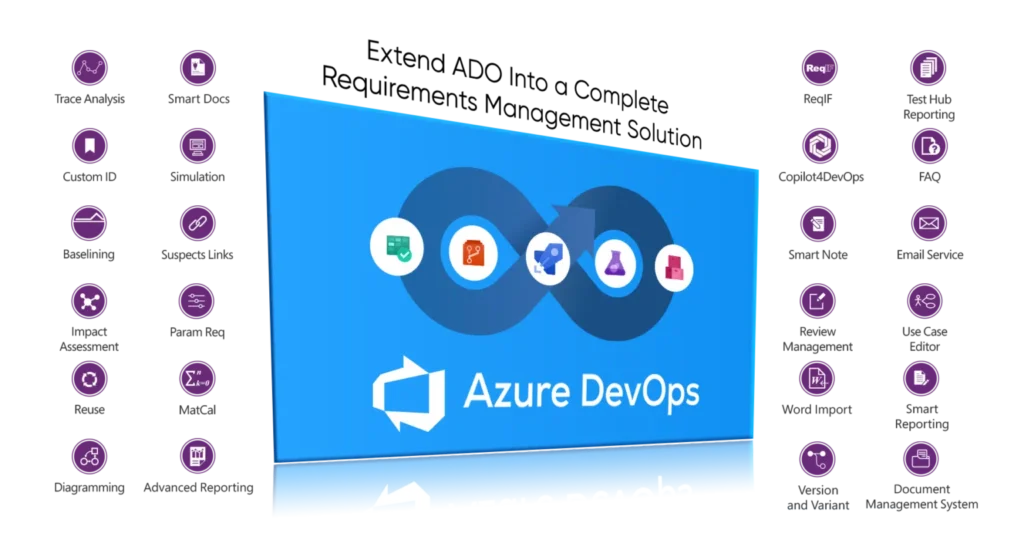
Smart Docs is feature of Modern Requirements4DevOps, a best-in-class requirements management solution. It extends Azure DevOps into a complete solution as it the only Requirements Management tool natively integrated into ADO. Besides Smart Docs, it also has intuitive document management features such as:
- Smart Reports: One-click generation and sharing of project snapshot reports within Azure DevOps.
- Traceability: Work item traceability within Azure DevOps with Horizontal and Intersectional traceability matrices available.
- Requirements Reuse: You can retrieve stored requirements and implement them within a new project with a highly efficient Reuse tool.
- Document Management System: built to manage documentation throughout the project lifecycle through document and folder uploading, organizing, and versioning.
- FAQs: Use a preexisting set of focused question lists grouped by system attribute and categorized by them being:
- Operational
- Revisional
- Transitional
By combining Smart Docs with Modern Requirements4DevOps’ vast feature set, you can radically increase your worker productivity and save costs.
Closing Thoughts
Modern Requirements4DevOps’ Smart Docs module and its AI tool, Copilot4DevOps, can simplify your documentation process within Azure DevOps. They ensure every requirement stays accurate and live.
These tools streamline workflows and reduce manual efforts, allowing your team to focus on value-added work. Consistent updates lead to improved project outcomes.
Remember to create reusable templates and manage versions for continuous improvement. This practice fosters better collaboration and document reliability.
Start your free trial today and see how Smart Docs can enhance your document creation process in Azure DevOps!
Frequently Asked Questions (FAQs)
Can We Store Documents in Azure DevOps?
Yes, Smart Docs integrates directly into Azure DevOps, securely storing your documents for centralized management.
How Do I Update Smart Docs Automatically?
Smart Docs syncs in real-time, so any change in requirements is instantly reflected across all linked documents.
What File Formats Can I Export My Smart Docs To?
You can export Smart Docs as Word, PDF, or HTML, ensuring flexible sharing and integration with other tools.
Can Multiple Users Collaborate on Smart Docs Simultaneously?
Yes, Smart Docs supports real-time collaboration, allowing team members to work concurrently on the same document.

